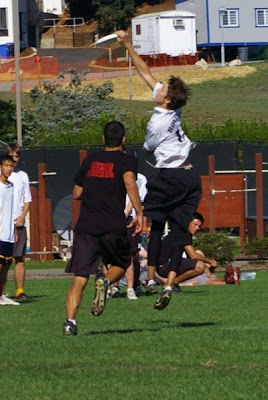Watching some new Survivorman with a few Les Stroud virgins at Anand's and Joel's proved pretty good in the latest Papa New Guinea episode. Things were rough, Les couldn't find good ground, escape from the rain and flooding waters, and any food of any sort besides plants. Eventually, towards the end, some local tribesmen came and got him and told him they were having a festival in his honor as they had never seen anyone come to survive out there. Les said alright, as he usually puts it in his realistic manner ("well, I could stay out here and suffer, or enjoy a festival in my honor.") I also am pretty sure he got a new tat this season, and definitely a sponsorship from Columbia.
This is when he drops the bomb and says it's the last survivorman. Came back to my apartment and confirmed it:
"You can only do seven days surviving without food a certain number of times a year. I'm pleased with what I have done, I've been copied around the world, but 25 times I've not eaten anything for a week while sleeping on rocks. I need to move on," Stroud told Reuters in a Thursday report.Well nuts. Just after this episode he kicked the Australian outback's ass by cooking up mad crustaceans, digging fat wormy things out of trees, and digging for water. A reminder, Bear Grylzzzs had to re-edit his Western Australian adventure when it was revealed he stayed in hotels each night as he neglected to metion in the original airings. God ol' Les makes sure you know the difference between someone you would actually want with you when in dire straits and a jackass who would jump in some ice lake and die 30 minutes later:
"It takes a lot out of me as I really do what I do for real, with no camera crew, no nights in hotels like others do, and it takes a toll on my body," Stroud told Reuters in an apparent not-so-subtle jab at Man vs. Wild, Discovery's other wilderness survival series.Hmm... On a side note, Anand also told me about how gross one of my shares was in Google Reader this week. I had no idea he was able to see these things and was pretty confused. Anand and I are gchat buds, but I have many gchat buds that I just picked up through frequent emails. Like group members, and one or two professors. So apparently anyone in my chat list who uses reader can see these things. This is an urgent, urgent request to google. Please save reader for me before I get a boss who uses gmail and reader and ruins sharing forever. Did everyone realize this? Let me pick who I can share with for my posts... not for each individual posts, I am over the "reshare thing," I am way more concerned about mom someday seeing my shares.
Update: Nevermind, I'm an idiot. Check out "Share Settings". Thanks D.







